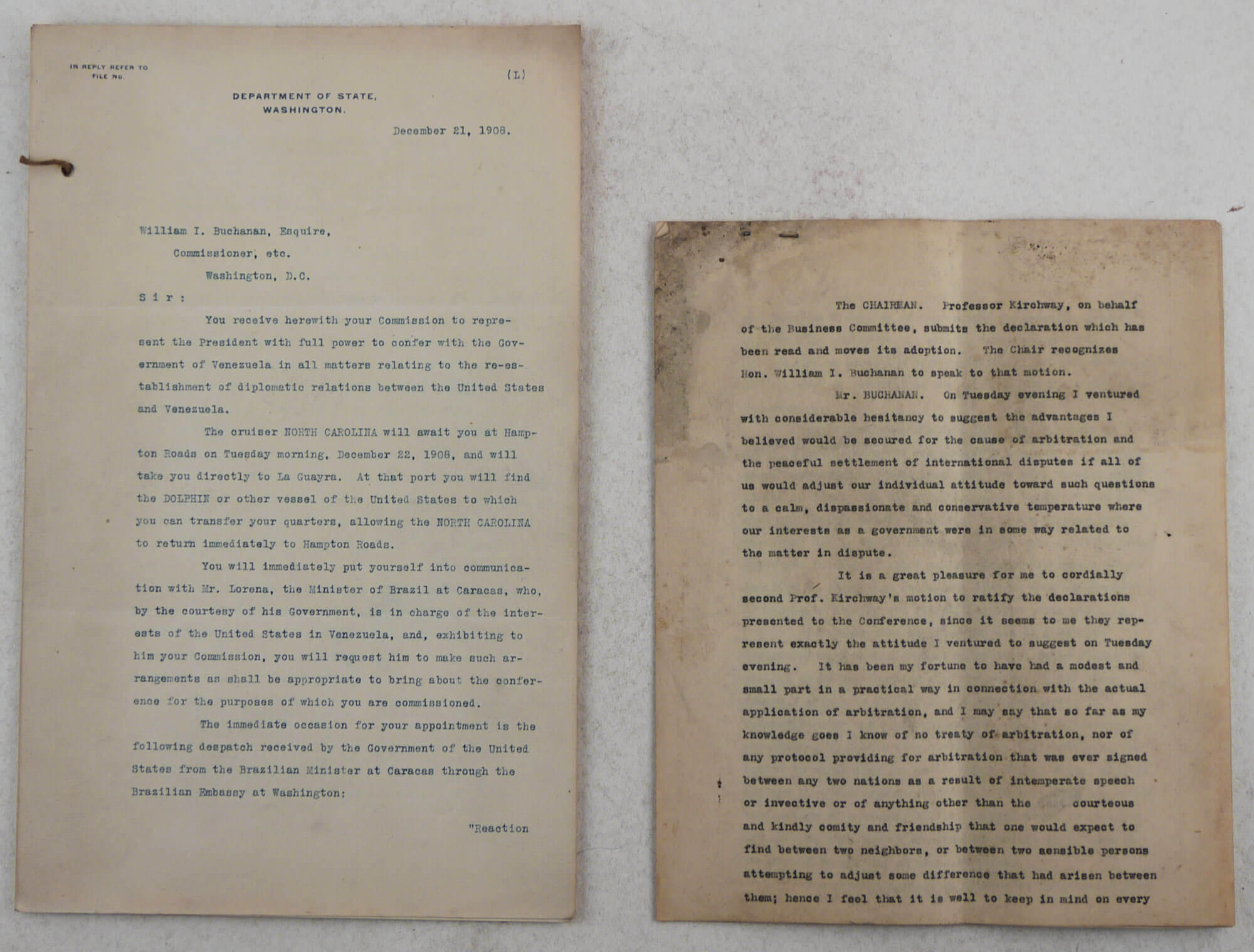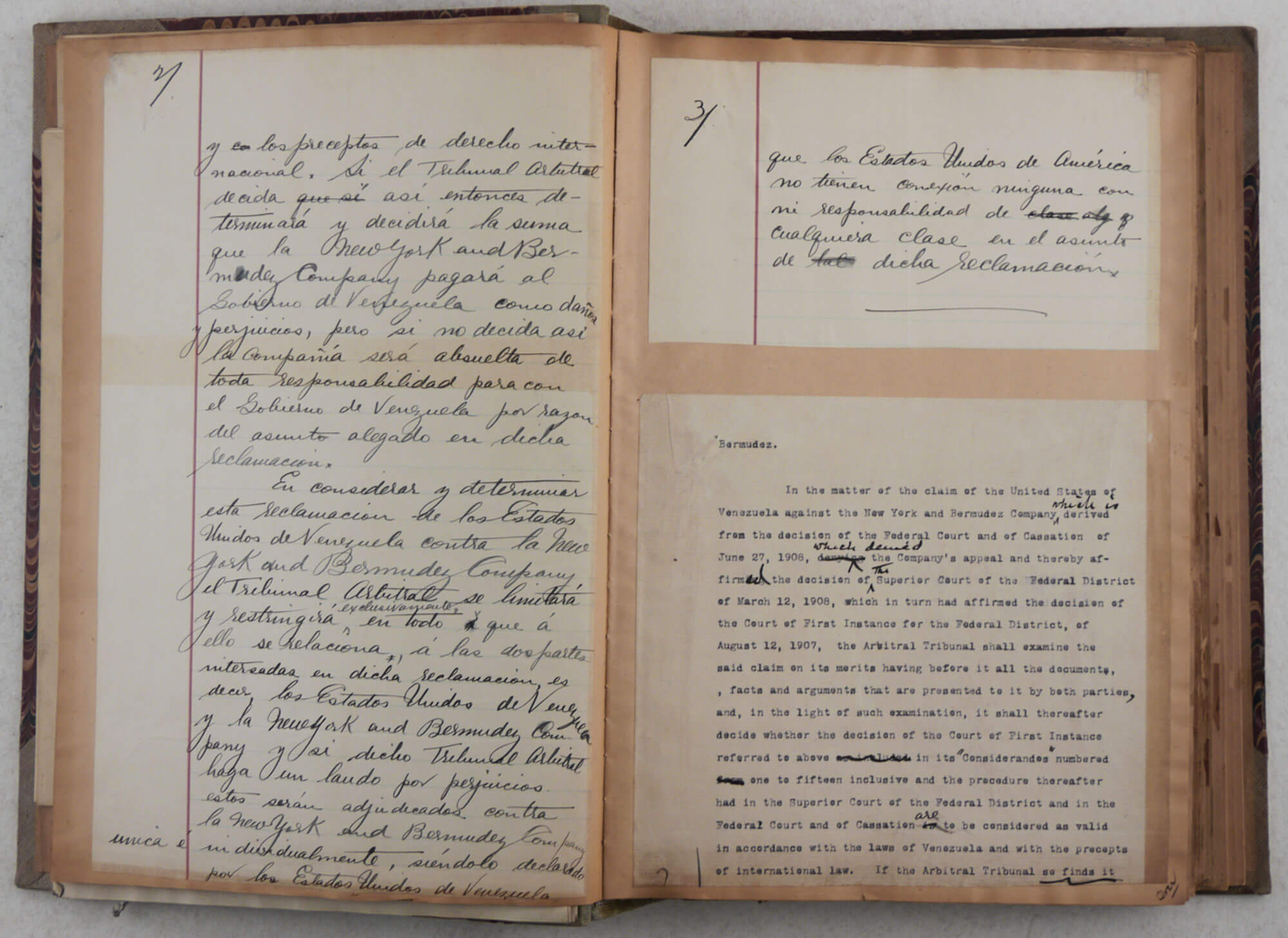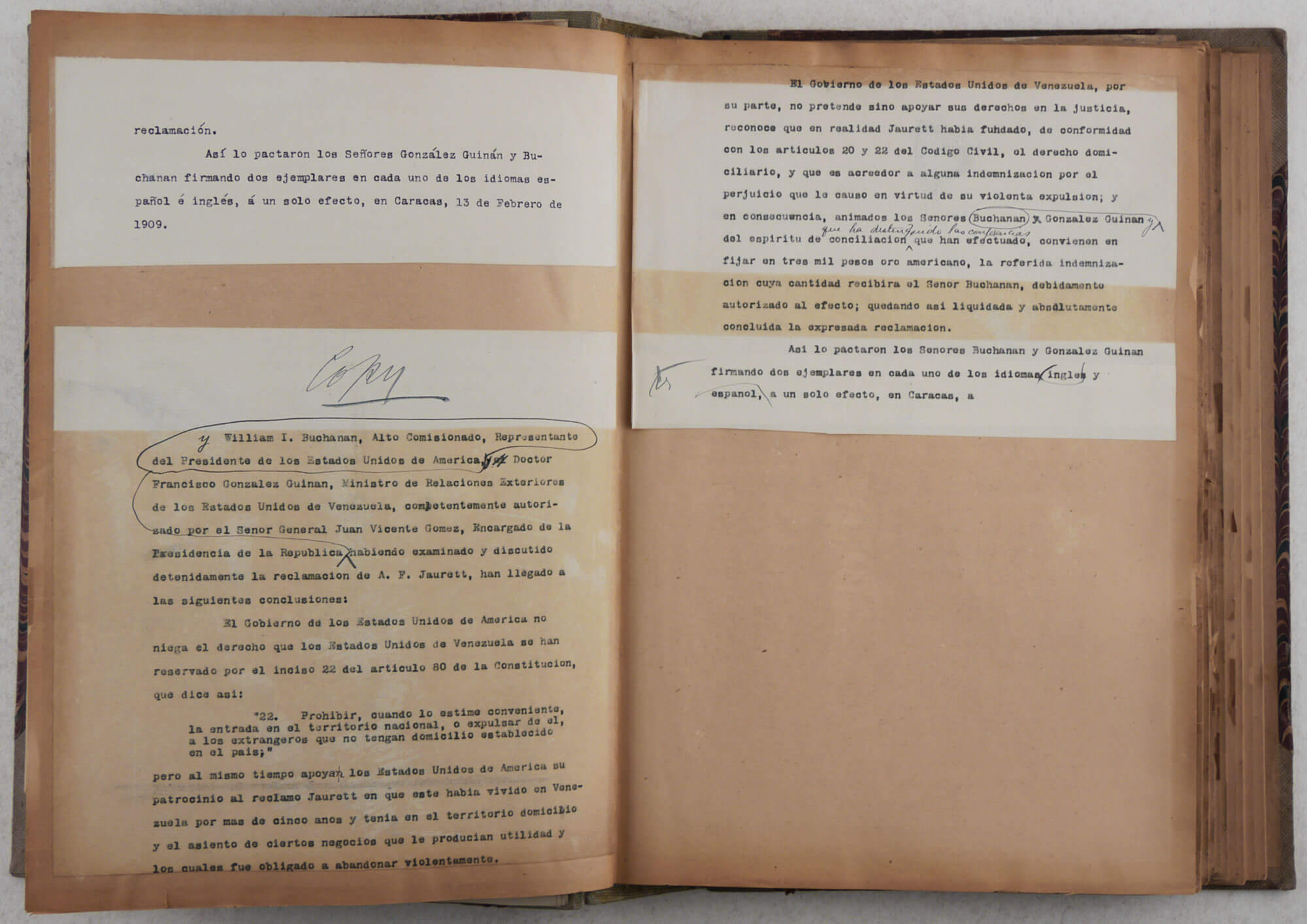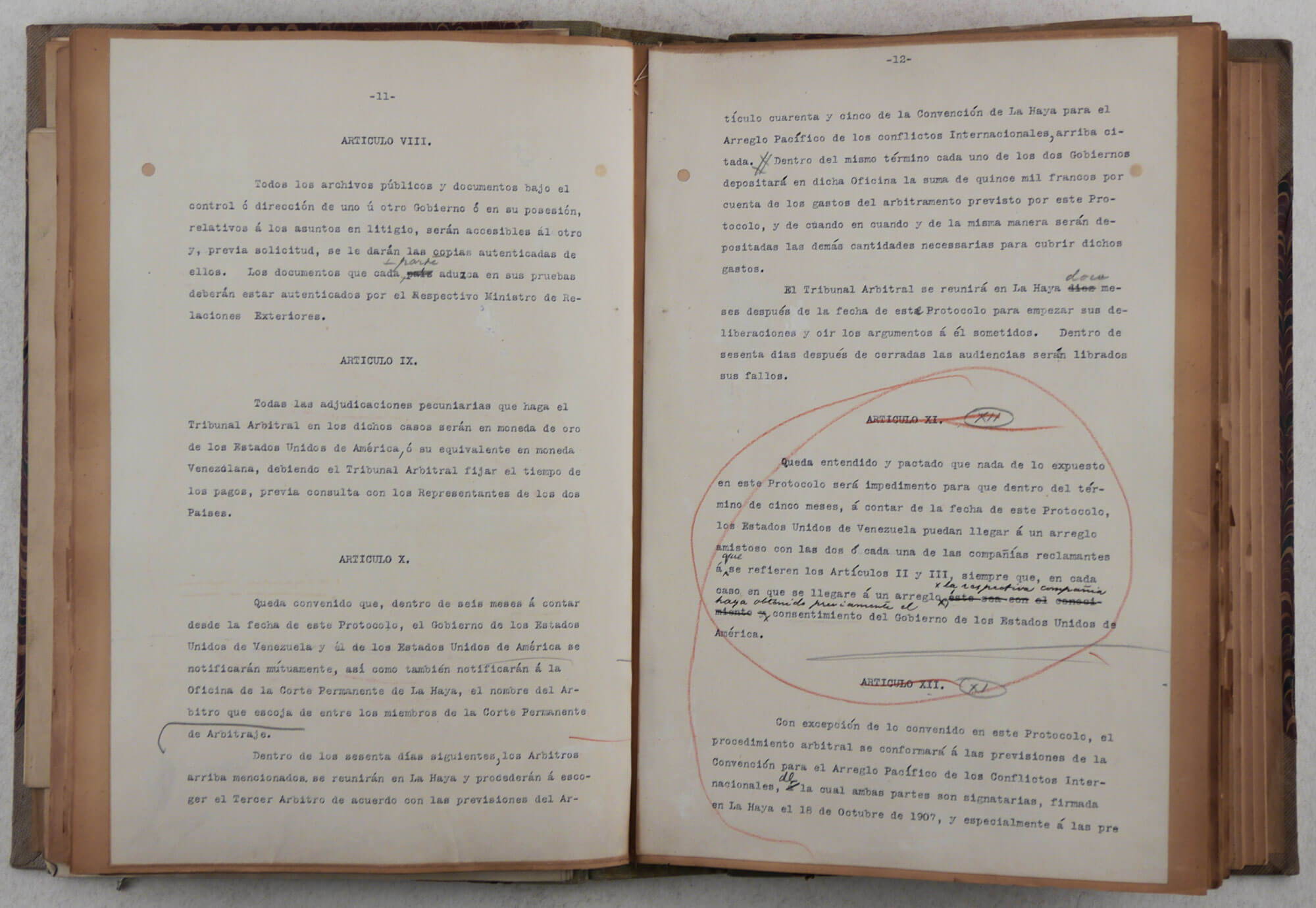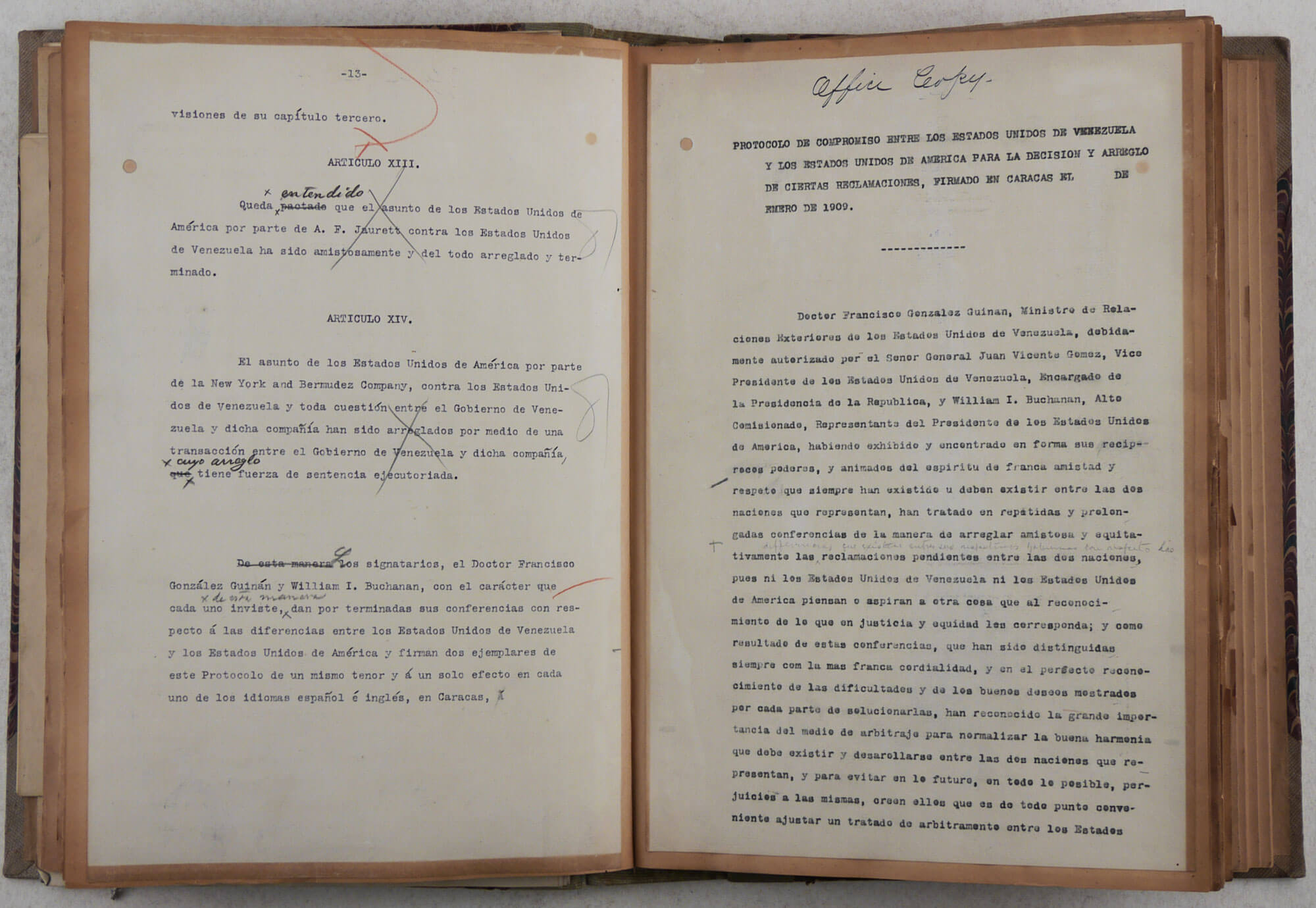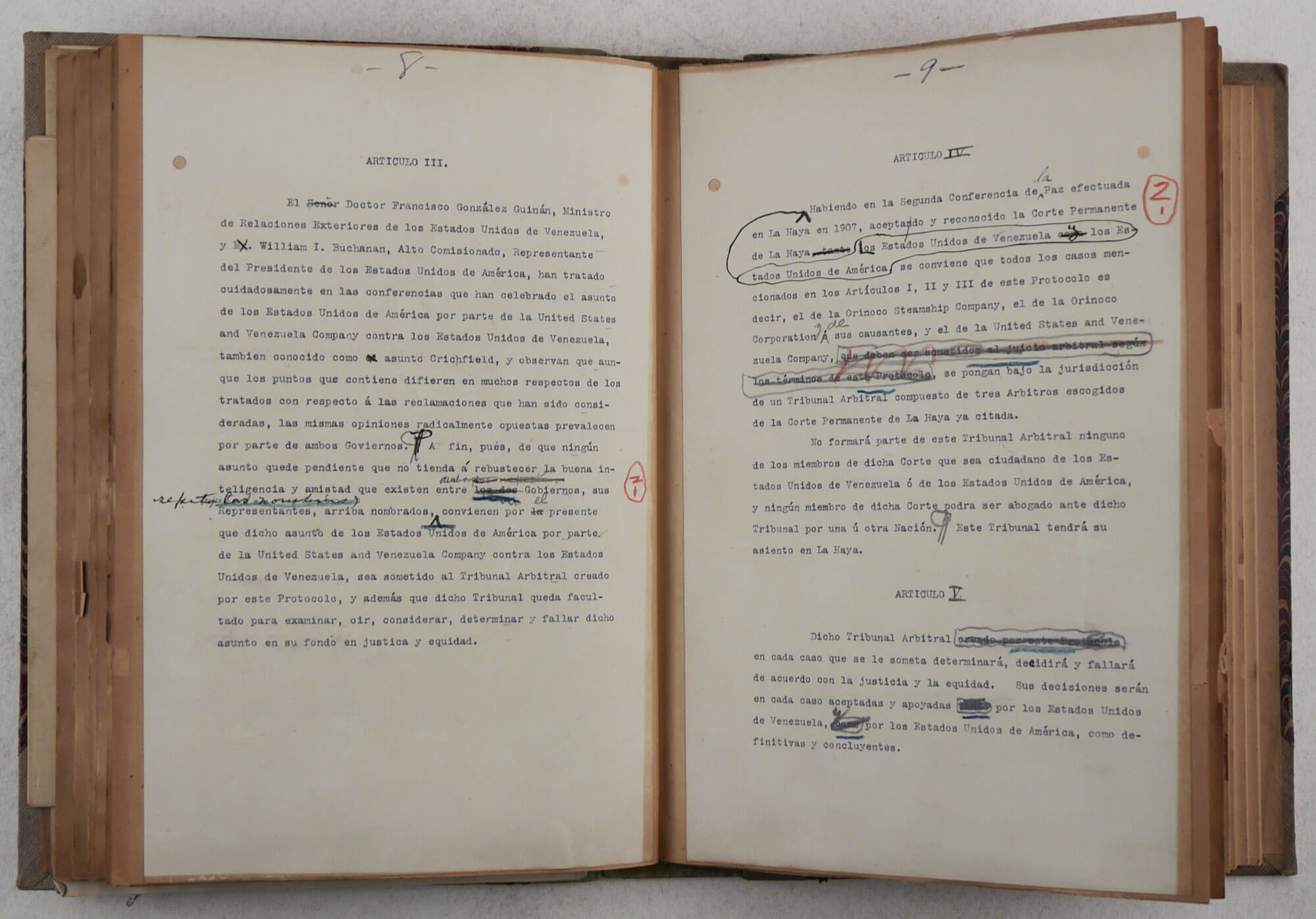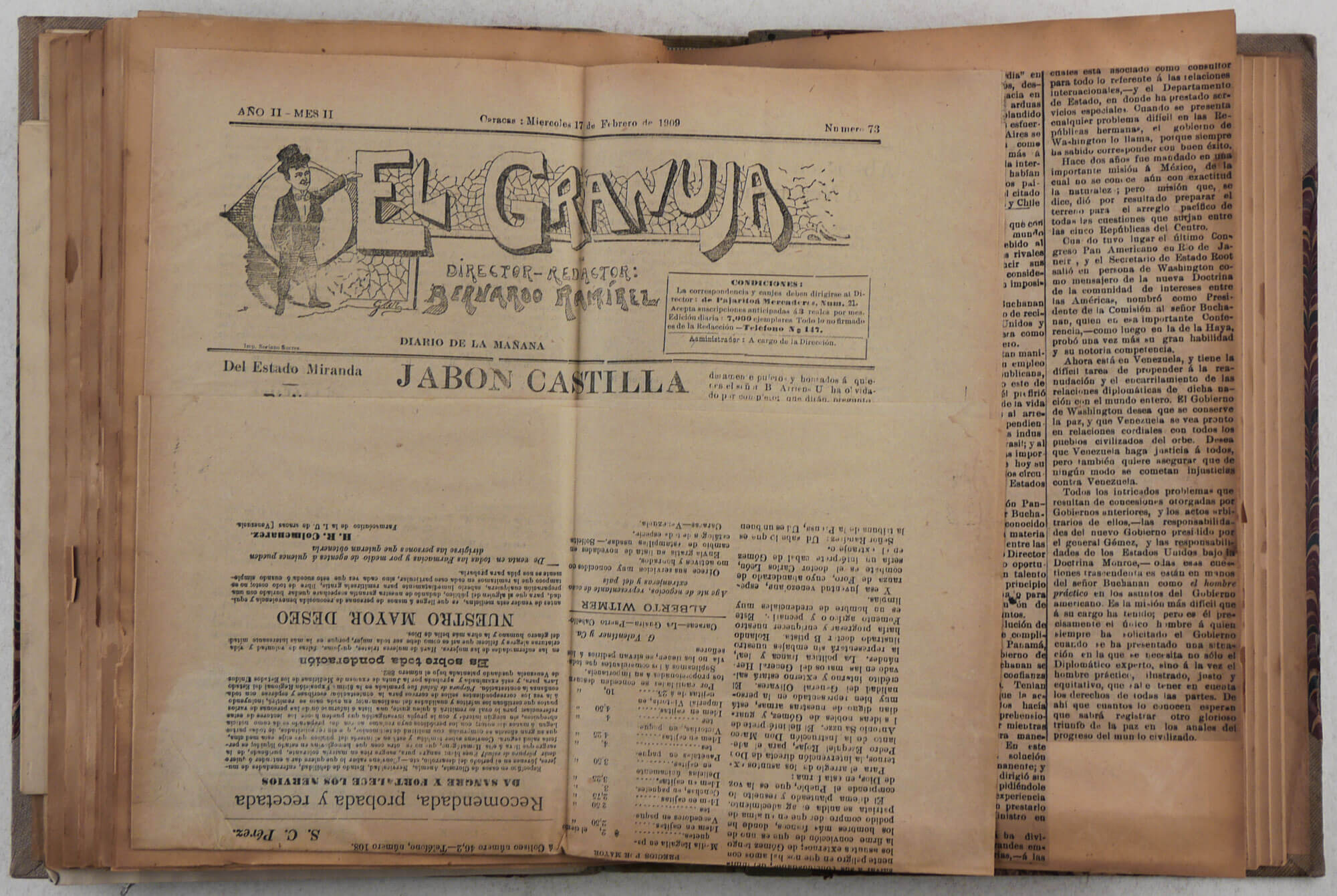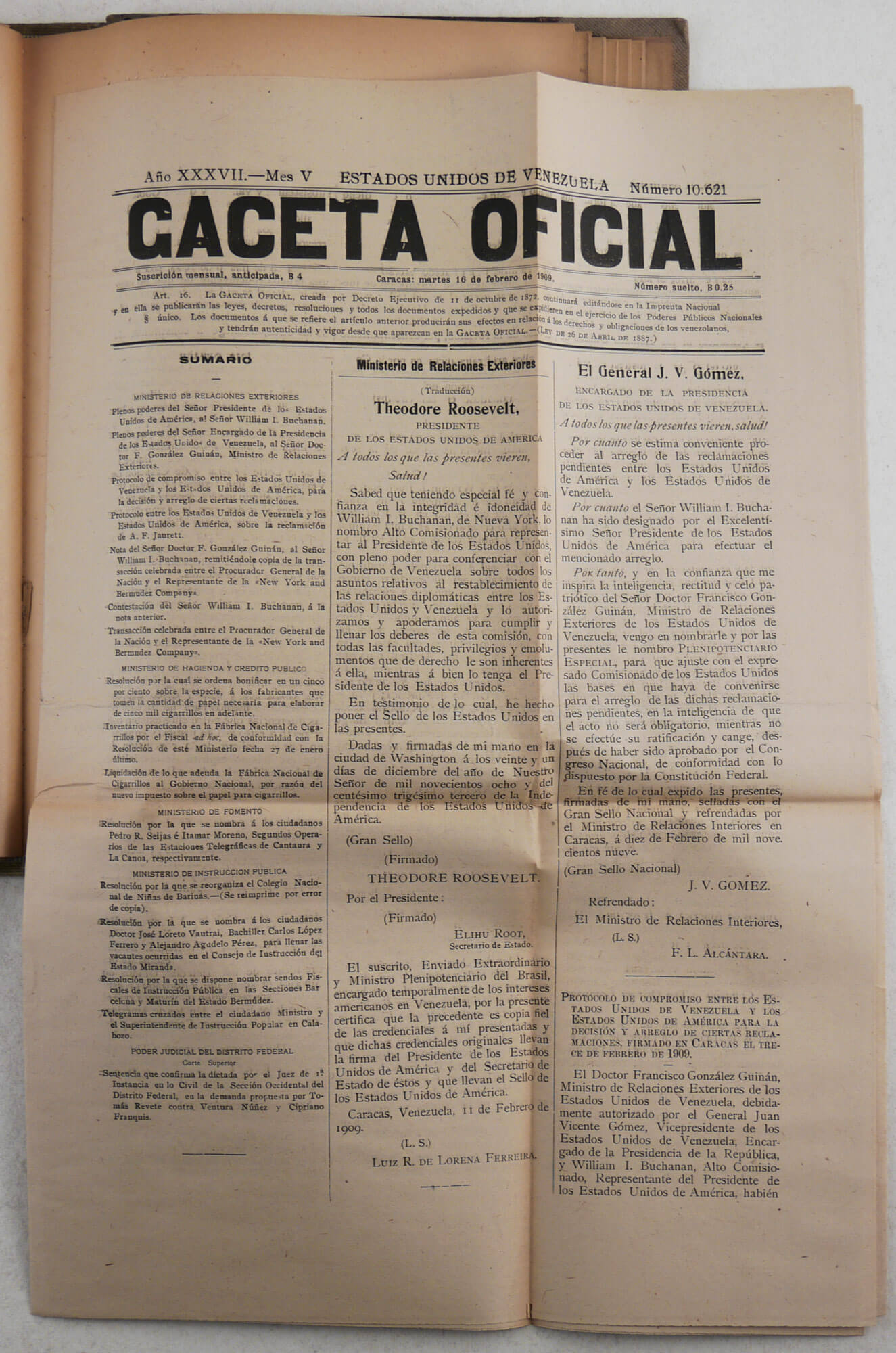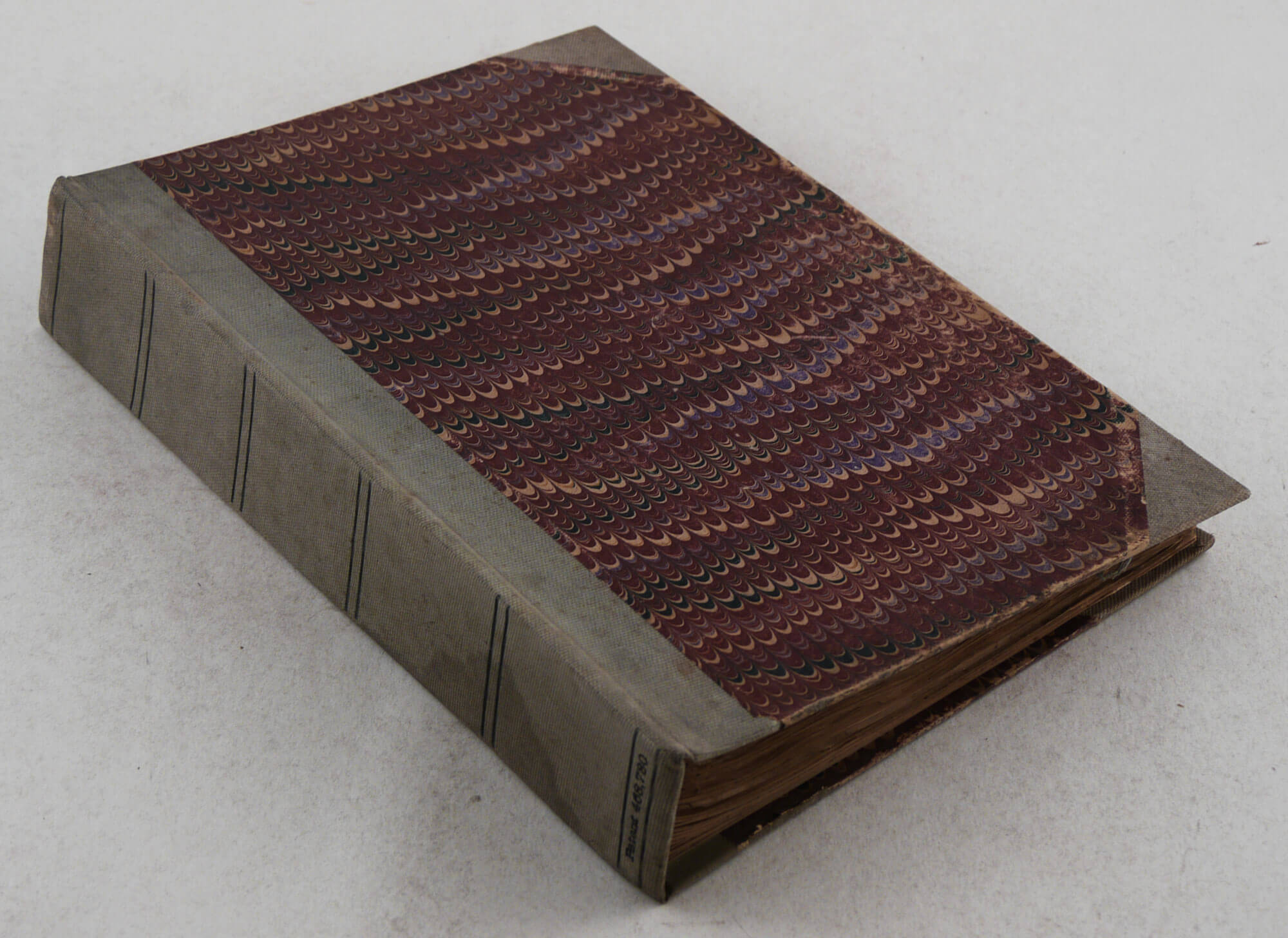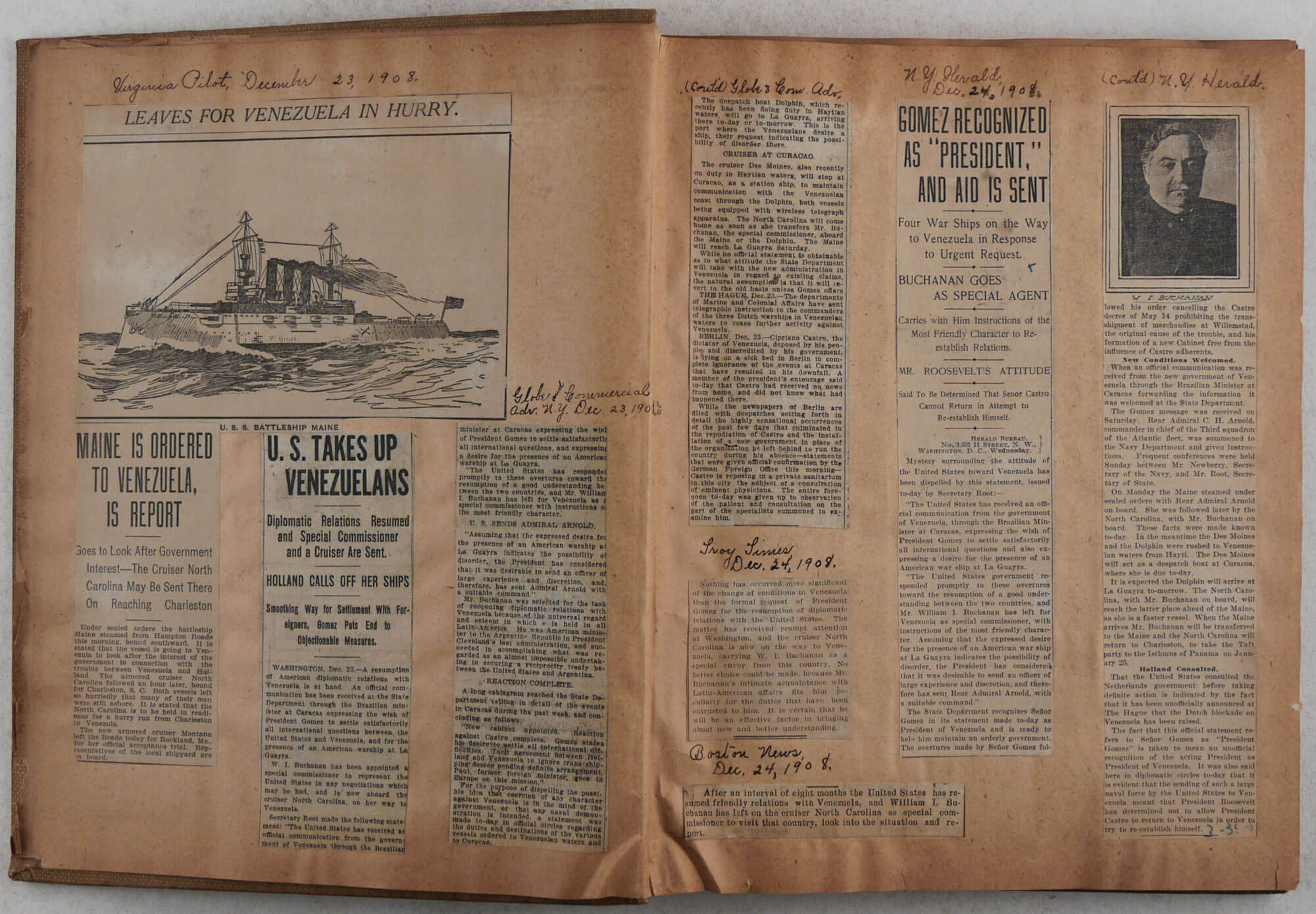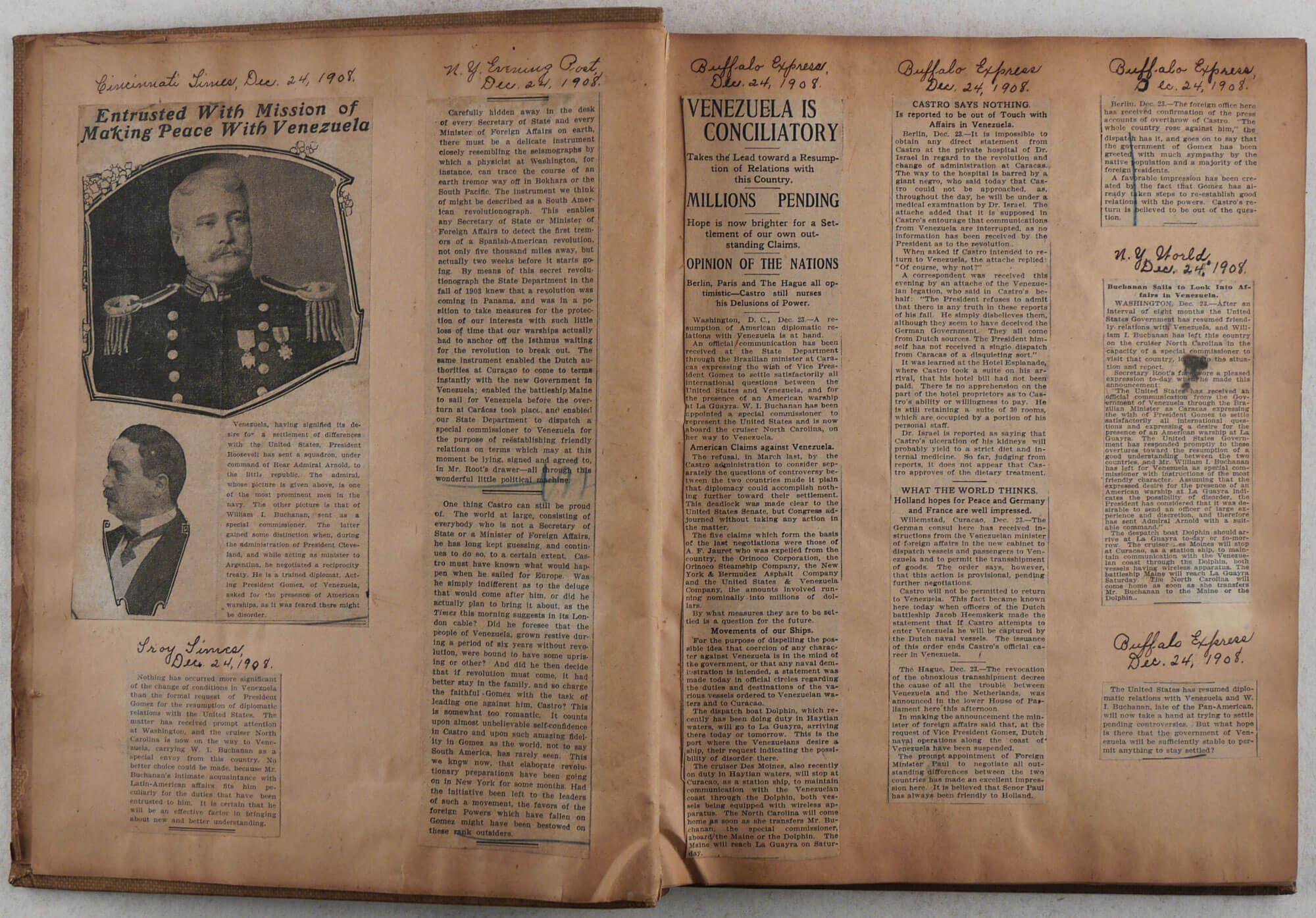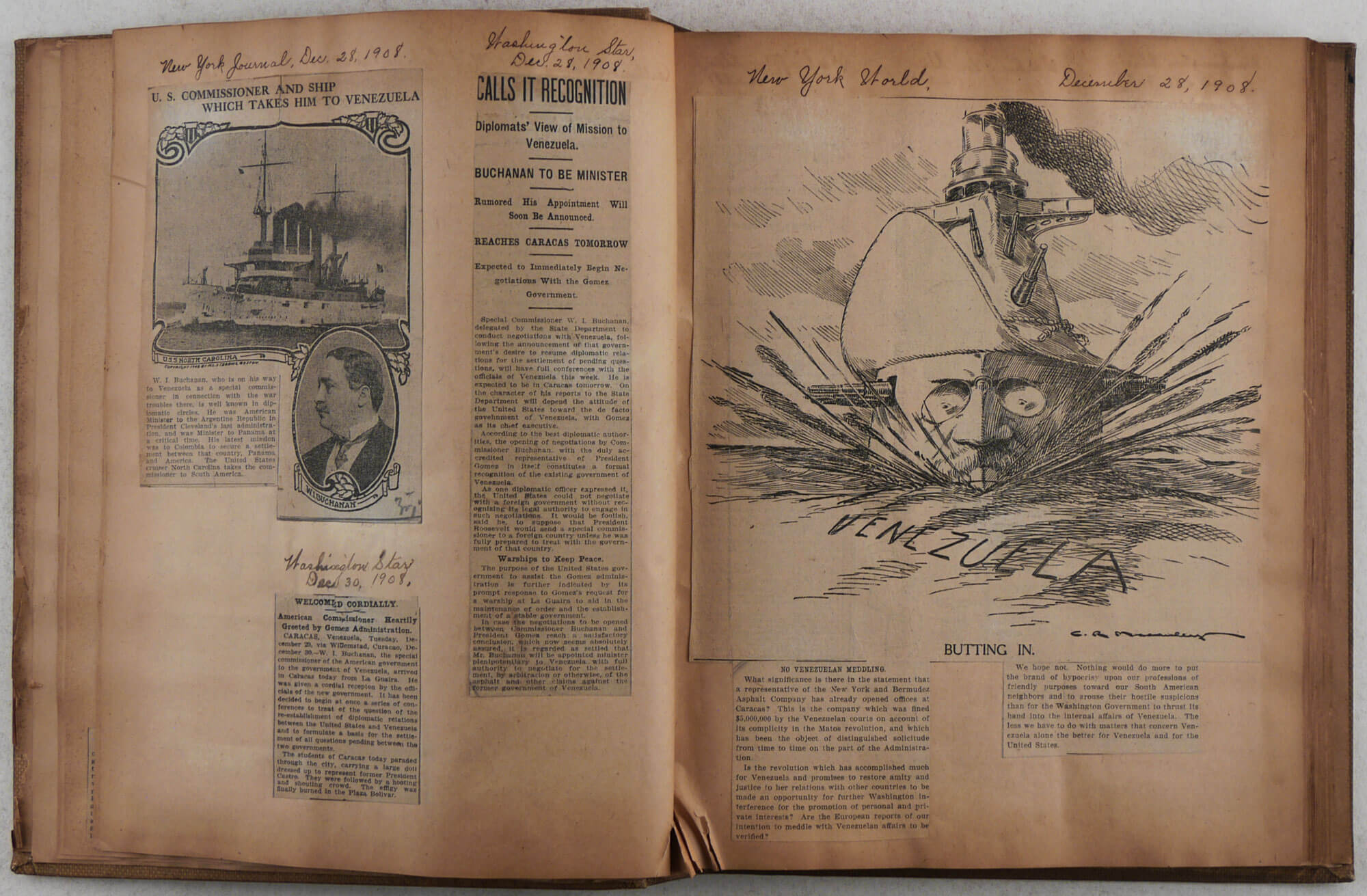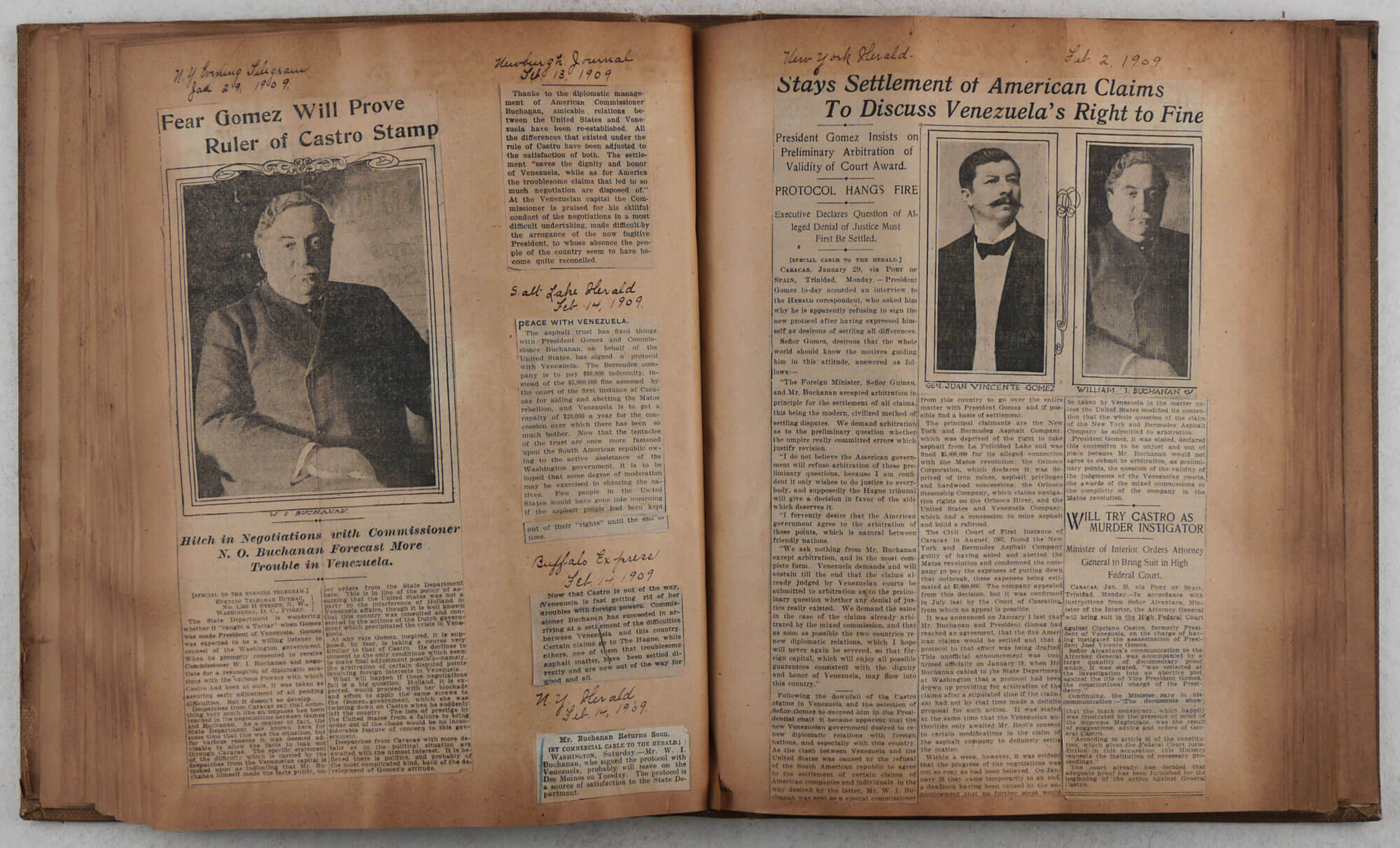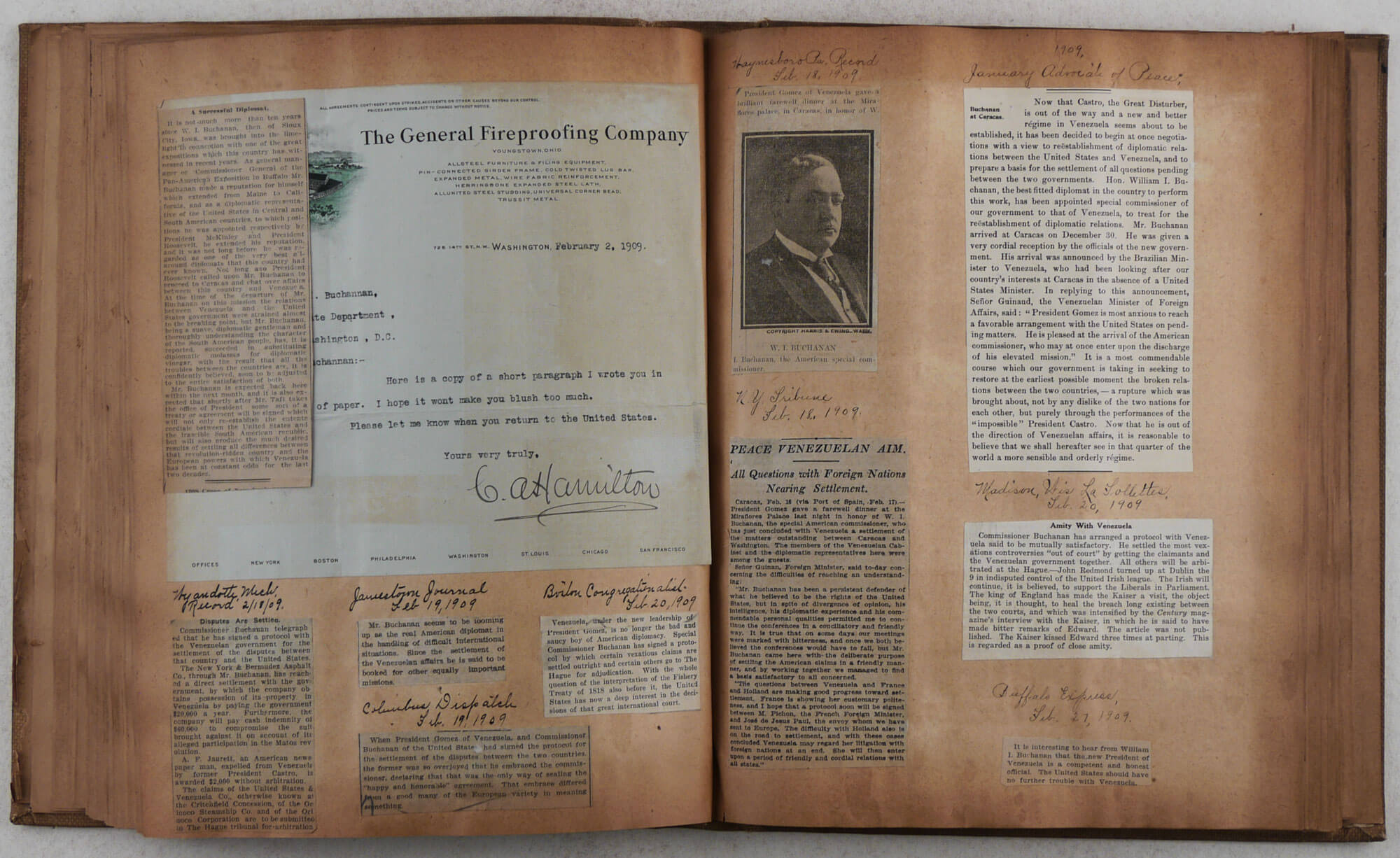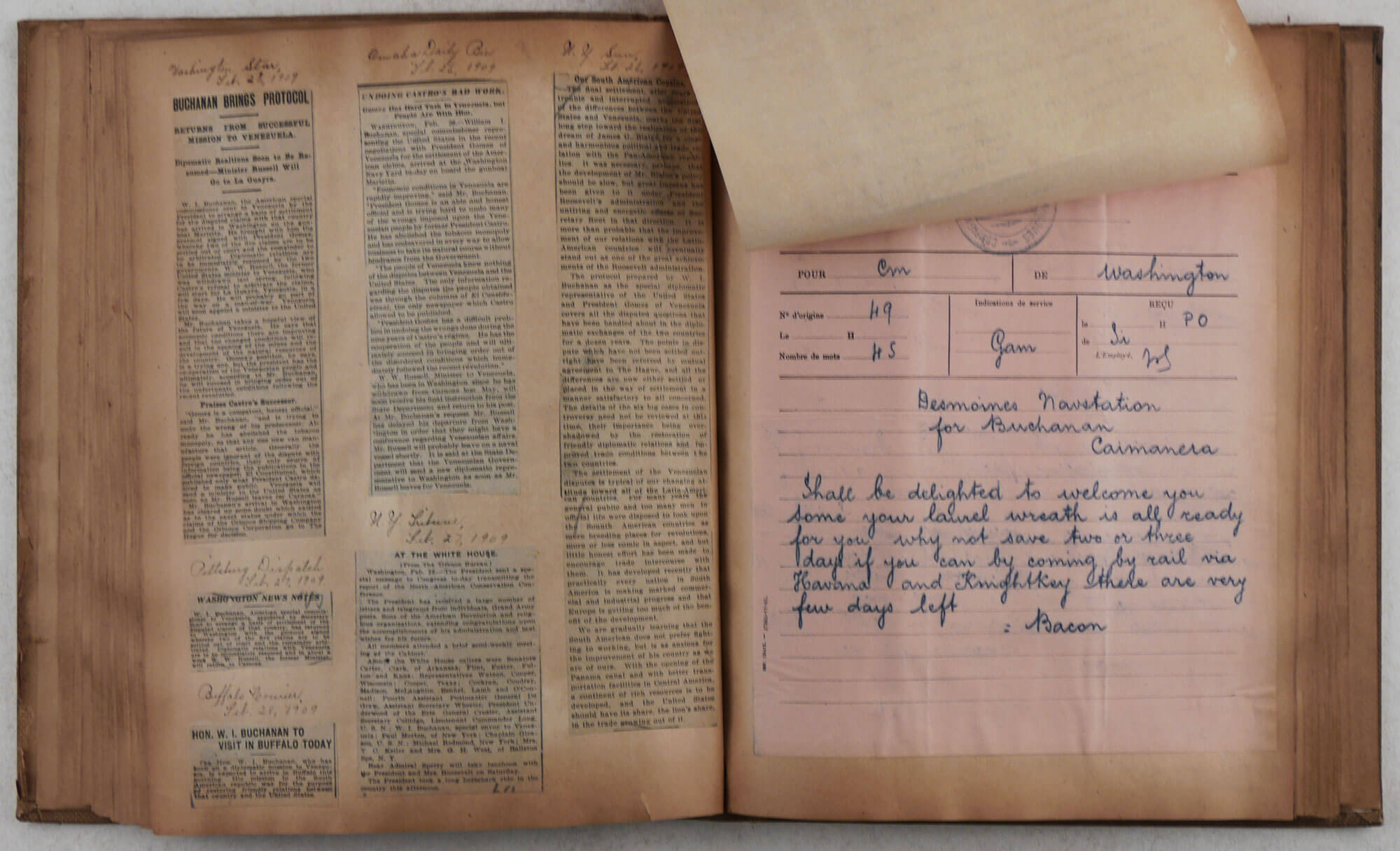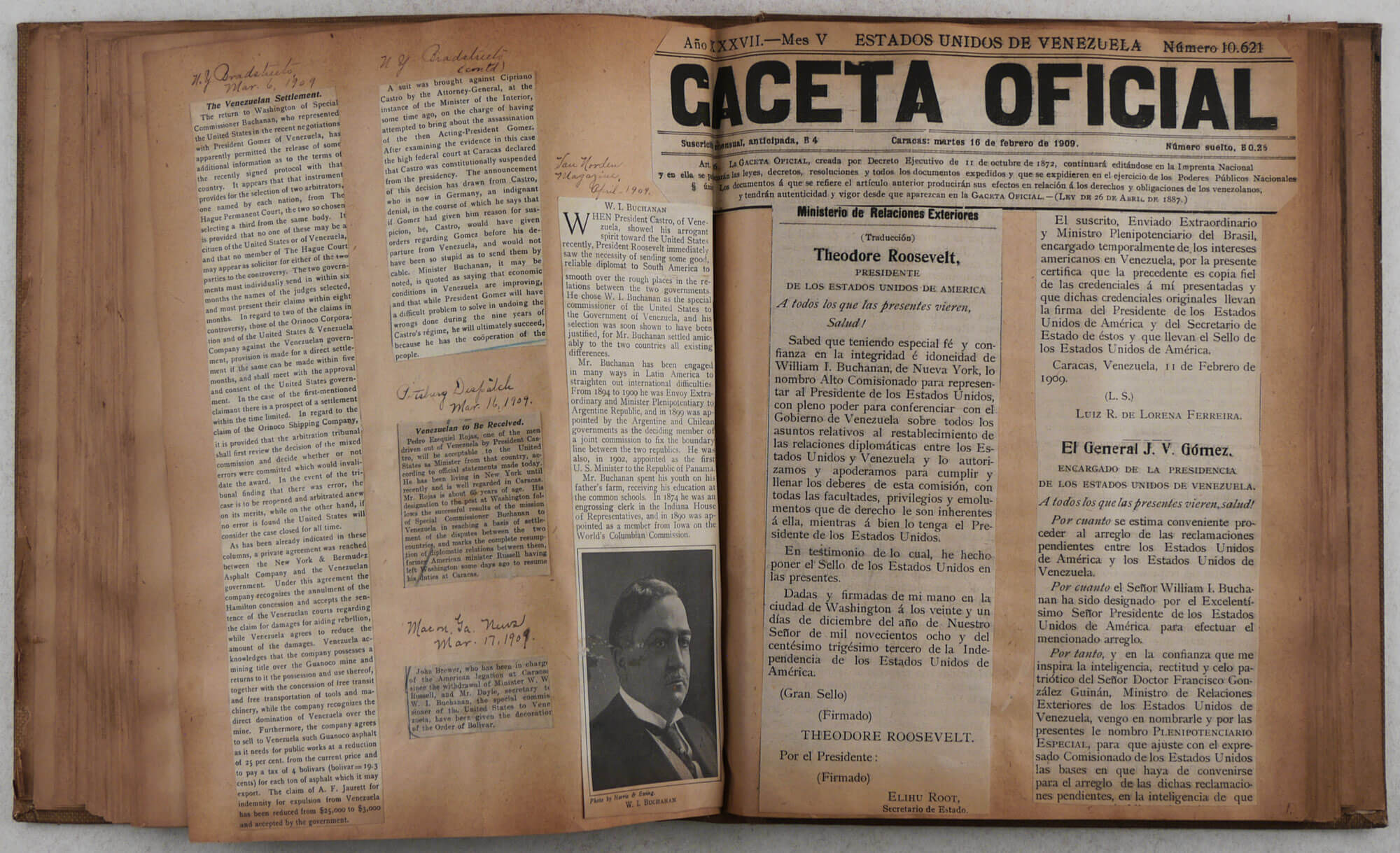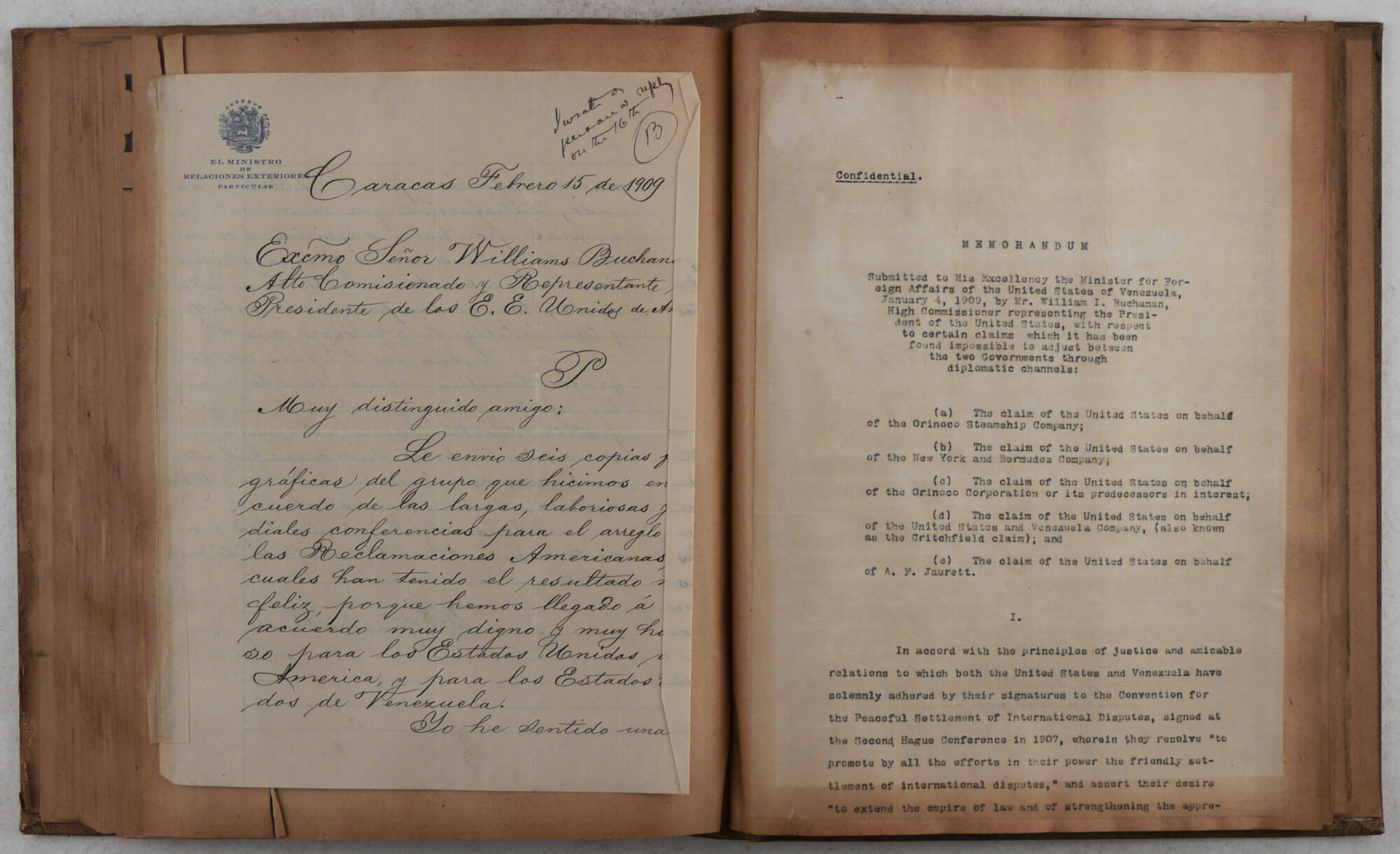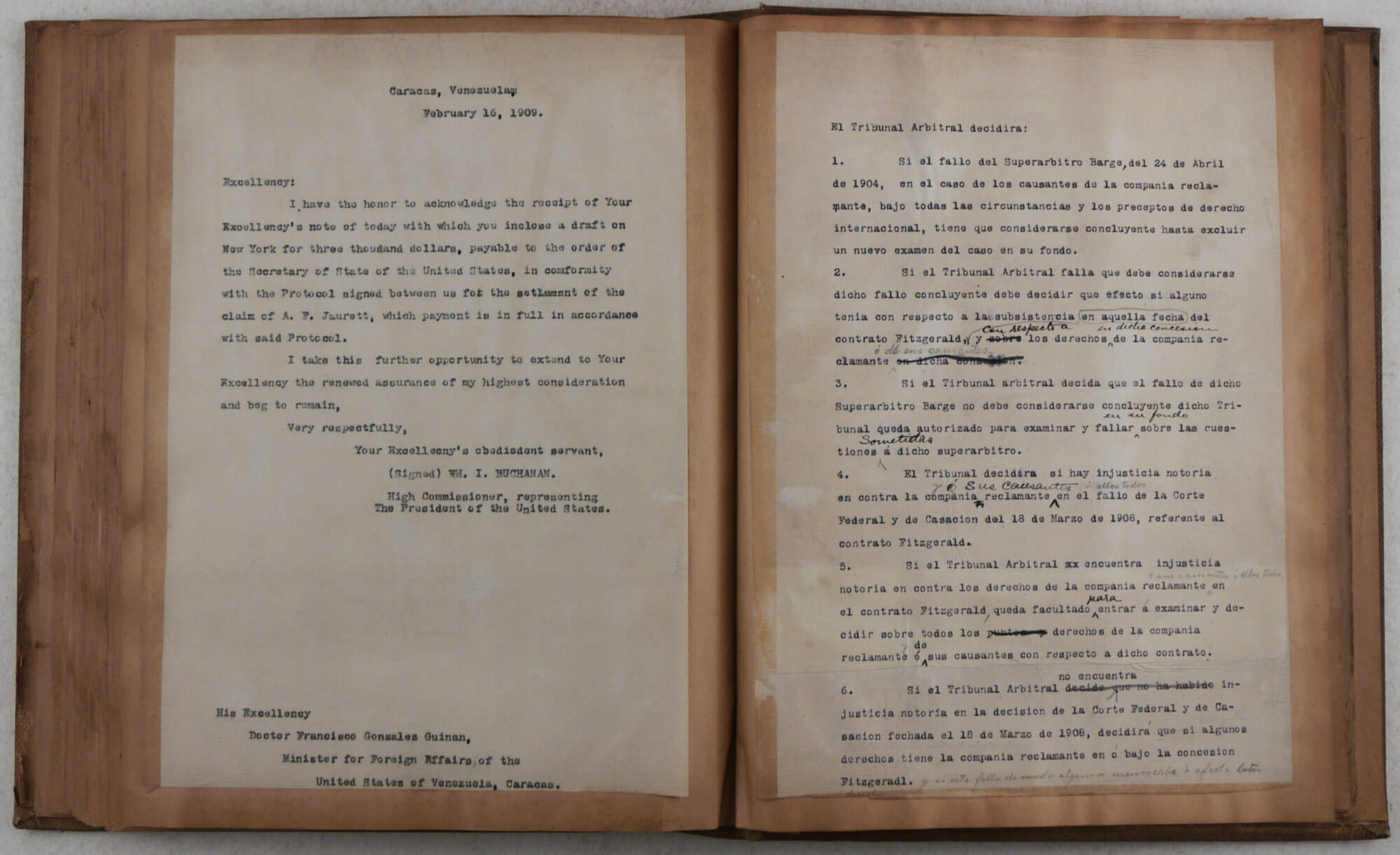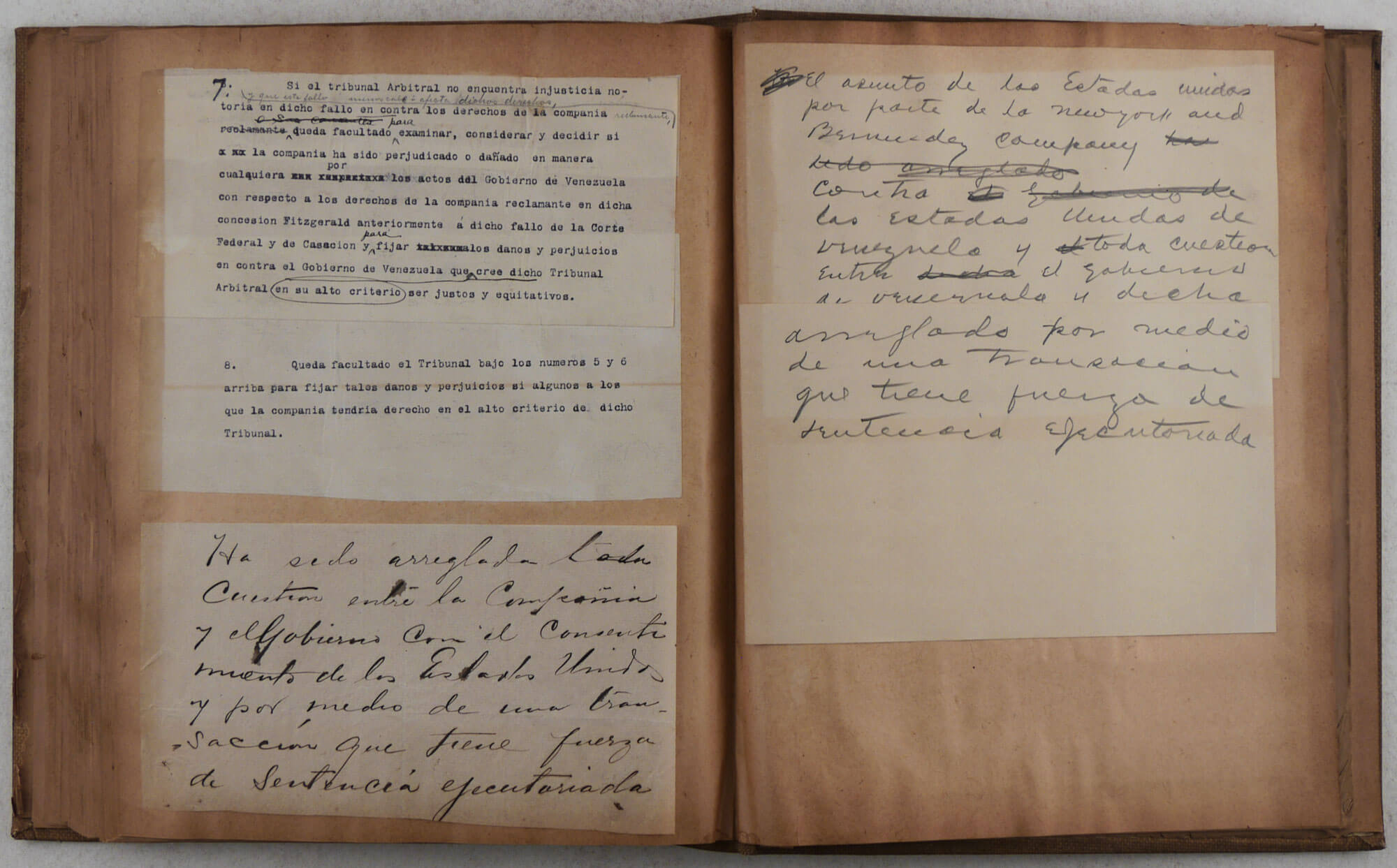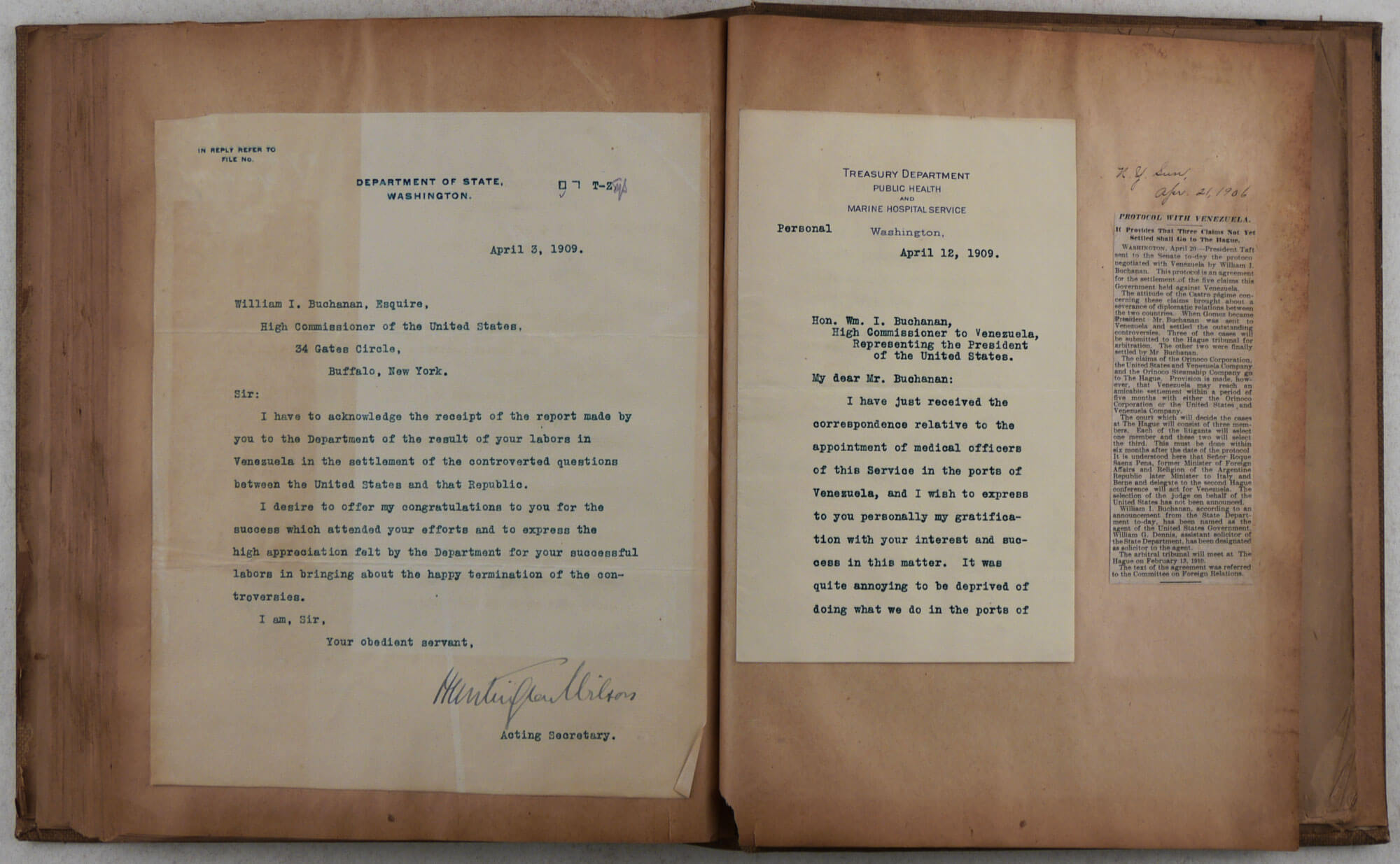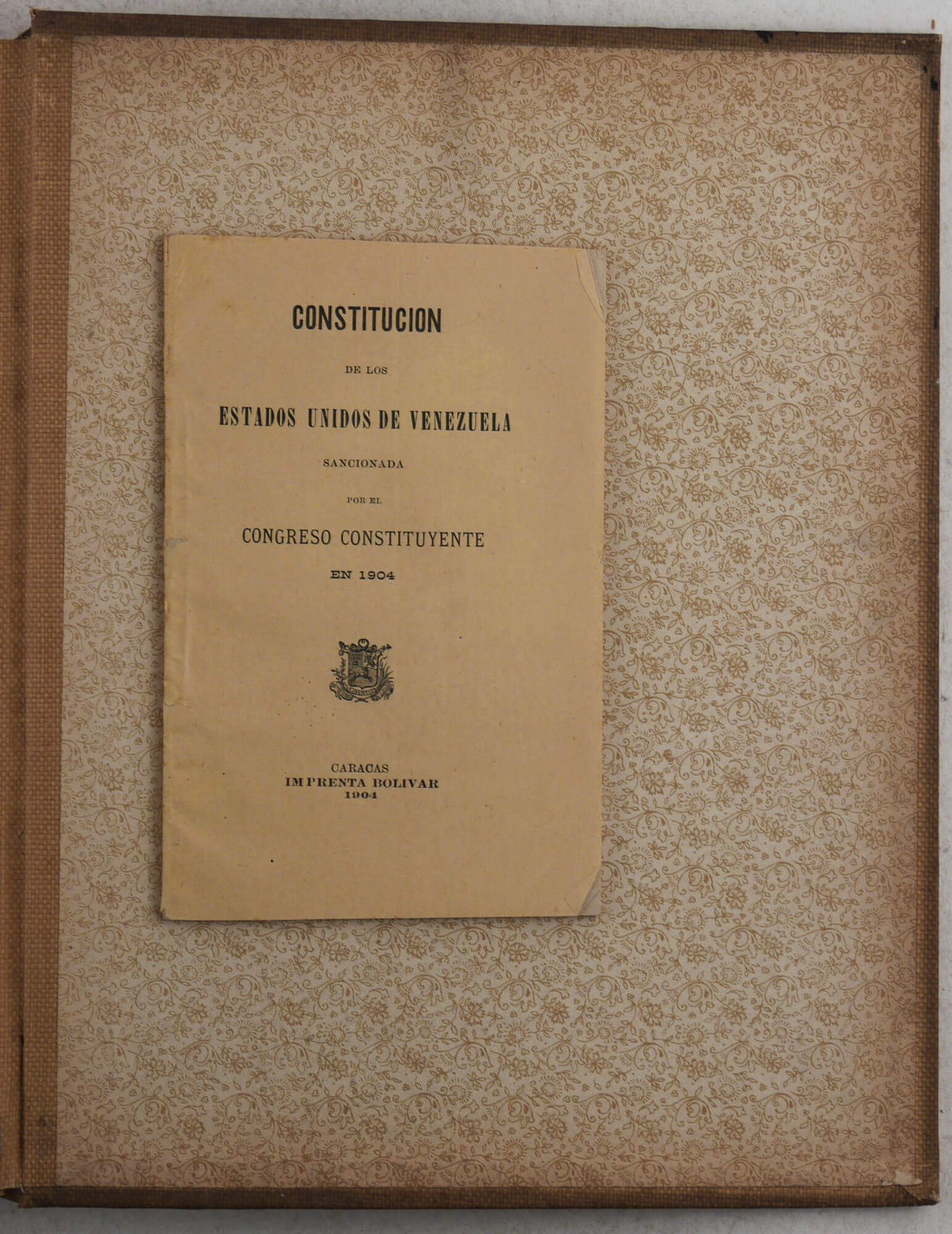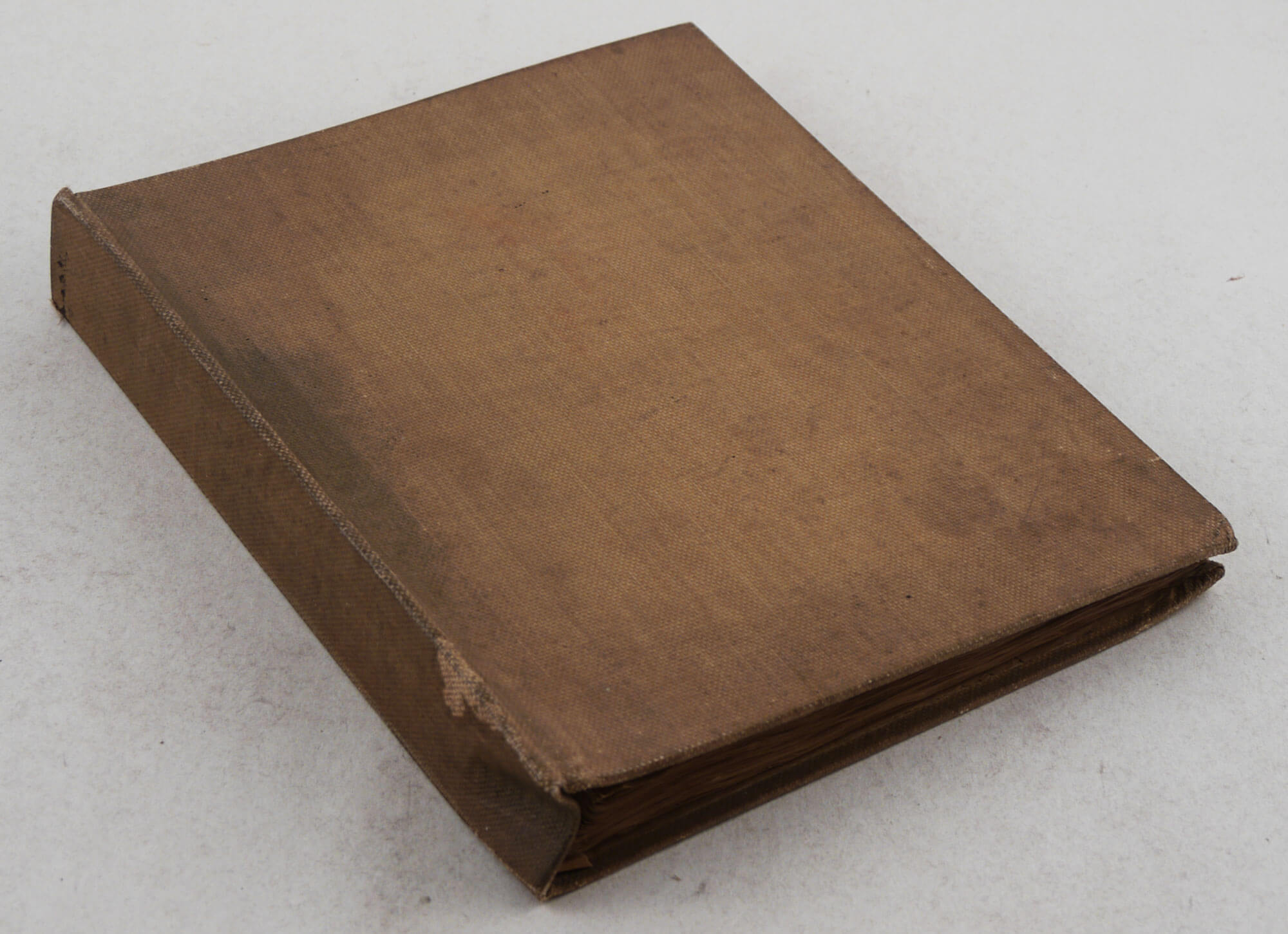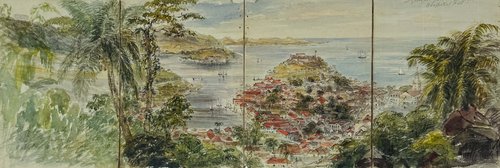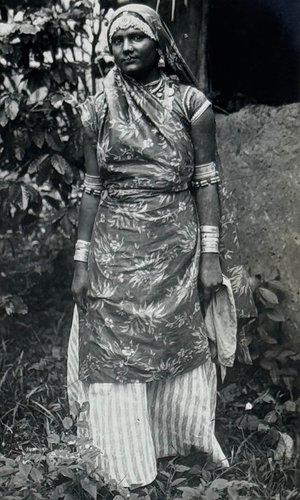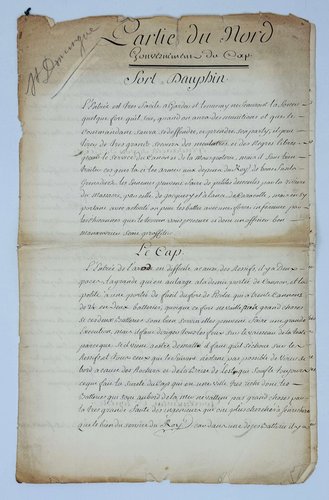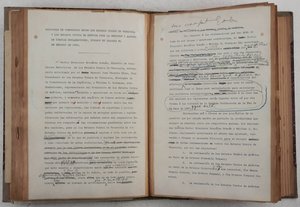
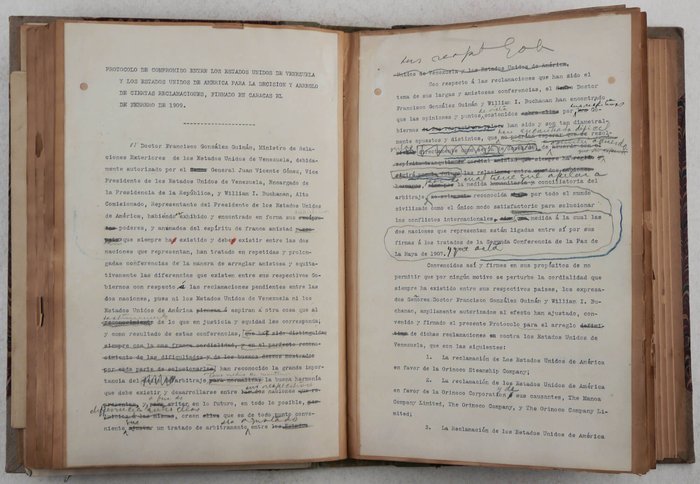
























#MC75ab
December 1908 – April 1909
Two original Folio journals/scrapbooks.
Journal/scrapbook 1: ca. 34x23,5 cm (13 ¼ x 9 ¼ in). Ca. 100 wove leaves (about half blank). With 17 mounted manuscript and typewritten documents in Spanish and English, occupying 80 pp. (40 leaves on recto and verso); period pencil and ink notes and corrections in text; three with typewritten notes “Confidencial.” With ten mounted period Venezuelan newspaper clippings and four entire Venezuelan newspapers, reporting about the arbitration process. With a loosely inserted official instruction to Buchanan from the Department of State, signed by the Secretary of State Elihu Root (ca. 33,5x21 cm, 21 December, 1909, 6 pp., typewritten). With a loosely inserted text of Buchanan’s speech at the 2nd National Peace Congress (May 3-5, 1909, ca. 26,5x21,5 cm, 5 pp., typewritten). Period grey half cloth with marbled papered boards. Binding slightly rubbed and soiled, leaves brittle, with minor chipping or tears on extremities, but overall a very good journal/scrapbook.
Journal/scrapbook 2: ca. 31,5x24,5 cm (12 ¼ x 9 ¾ in). 61 wove leaves. With five mounted manuscript and typewritten documents in Spanish and English (one signed by Venezuelan Foreign Minister Fr. Gonzales Guinan) and over 310 clippings from period American and Venezuelan newspapers (all dated in period ink on the top margins). With two Venezuelan imprints (1901 and 1904) in original publishers’ wrappers, mounted at the rear. Period light brown cloth binding, slightly rubbed and soiled. Leaves brittle, with minor chipping or tears on extremities, but overall a very good journal/scrapbook.
Historically significant archive of William I. Buchanan, a U.S. diplomat specialized in South America, documenting his role in reestablishing diplomatic relations between the United States and Venezuela in December 1908 – February 1909.
The relations were severed in June 1908, following several years of diplomatic crisis, started by the so-called Venezuelan claims controversy of 1902-1903. Four U.S. companies (New York and Bermudez Asphalt Co., Orinoco Steamship Co., United States and Venezuela Co., Orinoco Corporation) disputed the expropriation of their properties or other discrimination measures imposed by the government of Venezuelan President Cipriano Castro (in office: 1899-1908). The fifth claim concerned the expulsion from Venezuela in 1904 of the editor of “Venezuelan Herald,” an American citizen Albert Felix Jaurett. After Castro’s overthrow in the coup d’etat on December 19, 1908, the government of new President Juan Vicente Gomez (first term: 1908-1913) signalled the readiness to settle the disputes. On December 21 that year, the U.S. Secretary of State Elihu Root (in office: 1905-1909) appointed Buchanan the U.S. High Commissioner in Venezuela. For two months, Buchanan negotiated with the Venezuelan Foreign Minister Francisco Gonzales Guinan (1841-1932) in Caracas and signed the final protocol on February 16, settling two claims (New York and Bermudez Asphalt Co. and A.F. Jaurett) and sending the other to the International Court in the Hague.
The archive contains the texts of six versions of the settlement protocol (in Spanish), illustrating different stages of its discussion. The titles of the versions develop from “Project of Protocol, drafted by Mr. Buchanan, Caracas, January 14, 1909, submitted to Doctor Guinan” to “Protocolo de compromiso entre los Estados Unidos de Venezuela y los Estados Unidos de America para la decision y arreglo de ciertas reclamaciones, firmado en Caracas eltrece de Febrero de 1909.” Five versions contain manuscript corrections and notes in text; three are marked “Confidential.” Another confidential document is a “Memorandum, Submitted to H.E. the Minister for Foreign Affairs of the United States of Venezuela, January 4, 1909, by Mr. William I. Buchanan, High Commissioner representing the President of the United States, with respect to certain claims which it has been found impossible to adjust between the two Governments through diplomatic channels” (6 pp.).
The other documents include the decision of the Venezuelan “Arbitral Tribunal” regarding the claim of the “New York and Bermudez Company” (manuscript text in Spanish and typewritten translation into English, with Buchanan’s manuscript ink corrections); original letter to Buchanan signed by Venezuelan Foreign Minister, F.G. Guinan (with the official printed letterhead), typewritten copies of the letters of Venezuelan Minister of the Interior, General F.L. Alcantara and F.G. Guinan (regarding the settlement of A.F. Jaurett’s claim); an original letter to Buchanan from F.R. Bartlett, Attorney of the “N.Y. & Bermudez Co.;” a typewritten copy of Buchanan’s reply, congratulatory letters and telegrams to Buchanan from the new Secretary of State Robert Bacon, Department of State, Treasury Department, &c. There is also a loosely inserted official instruction to Buchanan from the Department of State, signed by Secretary of State Elihu Root on December 21, 1909 (6 pp.). Another loosely-inserted document is a five-page typewritten Buchanan’s speech at the Second National Peace Congress, held in Chicago on May 3-5, 1909. In the speech, Buchanan contemplates the principles of international arbitration and recalls his negotiations in Venezuela (pp. 3-4).
Over 320 carefully labelled clippings from period American and Venezuelan newspapers follow the entire negotiation process and summarize its results. Among the newspapers are “The Washington Post,” “Washington Star,” “New York Times,” “New York World,” “St. Paul Pioneer,” “Springfield Republican,” “Chicago Public,” Caracas newspapers – “Gaceta Oficial,” “Sancho Panza,” “El Preconero,” “El Tiempo,” and many others. The archive also contains the edition of 1904 Venezuelan Constitution (Constitucion de los Estados Unidos de Venezuela sancionada por el Congreso Constituente en 1904. Caracas, Imprenta Bolivar, 1904) and a pamphlet of President Cipriano Castro, proclaiming him as Jefe Supremo of Venezuela (El Jefe Supremo de los Estados Unidos de Venezuela a la Asamblea Nacional Constituyente de 1909. Caracas: Imprenta Nacional, 1901).
Overall an important extensive private archive documenting the reestablishment of diplomatic relations between the United States and Venezuela in 1909.
Having become known for the organization of the Corn Palace Expositions in Sioux City (Iowa) in 1882, Buchanan became a member of the Iowa Commission of the World’s Columbian Exposition and in 1890, was appointed the chief of its Department of Agriculture; in 1891 – chief of its livestock and forestry department, continuing his work throughout the Exposition (May – October 1893). In 1894-1900, Buchanan served as Envoy Extraordinary and Minister Plenipotentiary in Buenos Aires, contributing to delineating the Agrentinian-Chilean boundary in the Puna de Atacama. In 1901, he was director-general of the Pan-American Exposition in Buffalo, in 1902 – a U.S. delegate to the 2nd Pan-American Conference in Mexico, where he succeeded due to his “conciliatory attitude” and “profound and sympathetic knowledge of Latin America” ([Obituary of] William Insco Buchanan// The American Journal of International Law. Vol. 4, No. 1 (January 1910), p. 162). As a result, he became the first U.S. Envoy Extraordinary and Minister Plenipotentiary in Panama (1903-1904). In July-August 1906, Buchanan was the leader of the U.S. delegation at the Third Pan-American Conference in Rio de Janeiro. In 1907, he represented the United States at the 2nd Hague Peace Conference and the Central American Peace Conference (Washington, D.C.). In December 1908 – February 1909, in the rank of the U.S. High Commissioner to Venezuela, Buchanan negotiated two claims of a U.S. company and a citizen with the Venezuelan Foreign Minister Francisco Guinan, restoring diplomatic relations between the United States and Venezuela. To supervise the arbitration of the other cases, Buchanan went to Europe and suddenly died in London while at work in October 1909.


